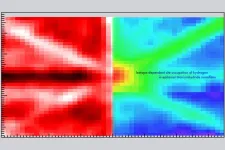(Press-News.org) PULLMAN, Wash. – A “deep learning” artificial intelligence model developed at Washington State University can identify pathology, or signs of disease, in images of animal and human tissue much faster, and often more accurately, than people.
The development, detailed in Scientific Reports, could dramatically speed up the pace of disease-related research. It also holds potential for improved medical diagnosis, such as detecting cancer from a biopsy image in a matter of minutes, a process that typically takes a human pathologist several hours.
“This AI-based deep learning program was very, very accurate at looking at these tissues,” said Michael Skinner, a WSU biologist and co-corresponding author on the paper. “It could revolutionize this type of medicine for both animals and humans, essentially better facilitating these kinds of analysis.”
To develop the AI model, computer scientists Colin Greeley, a former WSU graduate student, and his advising professor Lawrence Holder trained it using images from past epigenetic studies conducted by Skinner’s laboratory. These studies involved molecular-level signs of disease in kidney, testes, ovarian and prostate tissues from rats and mice. The researchers then tested the AI with images from other studies, including studies identifying breast cancer and lymph node metastasis.
The researchers found that the new AI deep learning model not only correctly identified pathologies quickly but did so faster than previous models – and in some cases found instances that a trained human team had missed.
“I think we now have a way to identify disease and tissue that is faster and more accurate than humans,” said Holder, a co-corresponding author on the study.
Traditionally, this type of analysis required painstaking work by teams of specially trained people who examine and annotate tissue slides using a microscope—often checking each other’s work to reduce human error.
In Skinner’s research on epigenetics, which involves studying changes to molecular processes that influence gene behavior without changing the DNA itself, this analysis could take a year or even more for large studies. Now with the new AI deep learning model, they can get the same data within a couple weeks, Skinner said.
Deep learning is an AI method that attempts to mimic the human brain, a method that goes beyond traditional machine learning, Holder said. Instead, a deep learning model is structured with a network of neurons and synapses. If the model makes a mistake, it “learns” from it, using a process called backpropagation, making a bunch of changes throughout its network to fix the error, so it will not repeat it.
The research team designed the WSU deep learning model to handle extremely high-resolution, gigapixel images, meaning they contain billions of pixels. To deal with the large file sizes of these images, which can slow down even the best computer, the researchers designed the AI model to look at smaller, individual tiles but still place them in context of larger sections but in lower resolution, a process that acts sort of like zooming in and out on a microscope.
This deep learning model is already attracting other researchers, and Holder’s team is currently collaborating with WSU veterinary medicine researchers on diagnosing disease in deer and elk tissue samples.
The authors also point to the model’s potential for improving research and diagnosis in humans particularly for cancer and other gene-related diseases. As long as there is data, such as annotated images identifying cancer in tissues, researchers could train the AI model to do that work, Holder said.
“The network that we’ve designed is state-of-the-art,” Holder said. “We did comparisons to several other systems and other data sets for this paper, and it beat them all.”
This study received support from the John Templeton Foundation. Eric Nilsson, a WSU research assistant professor in the School of Biological Sciences, is also a co-author on this paper.
END
AI method can spot potential disease faster, better than humans
2024-11-14
ELSE PRESS RELEASES FROM THIS DATE:
A development by Graz University of Technology makes concreting more reliable, safer and more economical
2024-11-14
Concreting mistakes can be expensive. Concrete poured too quickly often leads to a lack of colour uniformity, irregularities in the structure and uneven surfaces. Particularly in the case of exposed concrete, expensive reworking using concrete cosmetics is then necessary, sometimes a wall may even have to be demolished. In addition, if the fresh concrete rises too quickly in the formwork, there is a certain risk potential for the workers, as this can cause the formwork to break. In their DigiCoPro project, Ralph Stöckl and ...
Pinpointing hydrogen isotopes in titanium hydride nanofilms
2024-11-14
Tokyo, Japan – Although it is the smallest and lightest atom, hydrogen can have a big impact by infiltrating other materials and affecting their properties, such as superconductivity and metal-insulator-transitions. Now, researchers from Japan have focused on finding an easy way to locate it in nanofilms.
In a study published recently in Nature Communications, researchers from the Institute of Industrial Science, The University of Tokyo have reported a method for determining the location of hydrogen in nanofilms.
Because they are very small, hydrogen atoms can easily migrate into the framework of other materials. Titanium absorbs hydrogen to give titanium hydrides, making ...
Political abuse on X is a global, widespread, and cross-partisan phenomenon, suggests new study
2024-11-14
A new study suggests that political abuse is a key feature of political communication on social media platform, ‘X’, and whether on the political left or right, it is just as common to see politically engaged users abusing their political opponents, to a similar degree, and with little room for moderates.
While previous research into such online abuse has typically focused on the USA, the current study found that abuse followed a common ally-enemy structure across the nine countries for which there was available data: Canada, France, Germany, Italy, Poland, Spain, Turkey, ...
Reintroduction of resistant frogs facilitates landscape-scale recovery in the presence of a lethal fungal disease
2024-11-14
(Santa Barbara, Calif.) — A remote lakeshore deep inside Yosemite National Park teems with life: coyotes, snakes, birds, tadpoles, frogs. The frogs are at the heart of this scene, which a decade ago was much different. It was quiet — and not in a good way. The frogs that are so central to this ecosystem were absent, extirpated by a deadly fungal disease known as amphibian chytrid fungus.
Now, thanks to the consistent and focused efforts of researchers and conservationists to save, then reintroduce, mountain yellow-legged frogs to this and numerous other lakes in Yosemite, their populations are again thriving.
A ...
Scientists compile library for evaluating exoplanet water
2024-11-14
ITHACA, N.Y. – By probing chemical processes observed in the Earth’s hot mantle, Cornell scientists have started developing a library of basalt-based spectral signatures that not only will help reveal the composition of planets outside of our solar system but could demonstrate evidence of water on those exoplanets.
“When the Earth’s mantle melts, it produces basalts,” said Esteban Gazel, professor of engineering. Basalt, a gray-black volcanic rock found throughout the solar system, are key recorders of geologic history, he said.
“When the Martian mantle melted, it also produced basalts. The moon is mostly basaltic,” he said. “We’re ...
Updated first aid guidelines enhance care for opioid overdose, bleeding, other emergencies
2024-11-14
Embargoed until 4 a.m. CT / 5 a.m. ET Thursday, November 14, 2024
DALLAS and WASHINGTON, Nov. 14, 2024 — The American Heart Association and the American Red Cross today released the “2024 Guidelines for First Aid,” which provide critical updates that equip first aid responders with the latest evidence-based practices to effectively respond to mild, moderate and life-threatening emergencies. The guidelines are published today in Circulation, the American Heart Association’s flagship journal.
“Providing first aid care is about recognizing that an emergency ...
Revolutionizing biology education: Scientists film ‘giant’ mimivirus in action
2024-11-14
The COVID-19 pandemic led to heightened public interest in learning about viruses and how they can cause diseases. There has been a lot of focus on communicating virology concepts to the general public in order to increase awareness about the spread and prevention of viral diseases.
When it comes to teaching biology, however, how do we explain microscopic processes like viral infections to students in the classroom?
In modern science education, seeing is believing—educators are now attempting to capture the attention of students by using eye-catching visuals and videos, instead ...
Genetic variation enhances cancer drug sensitivity
2024-11-14
By exploiting the genetic variation in cancer cells, an already approved cancer drug demonstrated enhanced effects against cancer cells in specific patient groups. This is shown in a recent study from Uppsala University, published in the journal eBiomedicine. The findings suggest a potential for more individually tailored and more effective cancer therapies.
The human genome is organised in 46 chromosomes, where all but the x and y chromosomes in men are present in two copies. This means that a person with a faulty gene on one chromosome most often has a functional version on the other. But during ...
Protective genetic mutation offers new hope for understanding autism and brain development
2024-11-14
Tel Aviv, Israel, 14 November 2024 – Tel Aviv University researchers have made a remarkable discovery that could revolutionize our understanding of genetic mutations and their role in brain development. The study, published today in Genomic Psychiatry, reveals that not all genetic mutations are harmful – some may actually offer protection against developmental disorders.
Led by Professor Illana Gozes, Director, The Elton Laboratory for Molecular Neuroendocrinology, the research team identified a protective inherited mutation in the Activity-Dependent Neuroprotective Protein (ADNP) gene. This finding challenges the traditional ...
Colombia's Dr. Natalia Acosta-Baena uncovers critical link between brain development and degeneration
2024-11-14
MEDELLÍN, Colombia, November 14, 2024 - In a breakthrough that bridges the gap between neurodevelopment and neurodegeneration, Dr. Natalia Acosta-Baena has identified a novel genetic syndrome that reshapes our understanding of brain disorders. Her research, featured in the latest Genomic Press Interview, reveals how a single gene involved in neuronal transport can influence both brain development and degeneration.
Dr. Acosta-Baena's discovery of a SPAG9 variant's role in both processes challenges the traditional view that neurodevelopmental disorders and neurodegeneration operate through distinct pathways. ...







